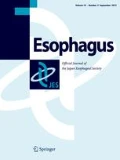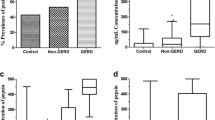Abstract
Background
Salivary pepsin measurement has been reported to be useful for diagnosing gastroesophageal reflux disease (GERD). This study aimed to clarify the usefulness of salivary pepsin measurement in patients with proton pump inhibitor (PPI)-refractory GERD symptoms without erosive esophagitis.
Methods
One hundred and two patients were included. Over seven days after terminating PPI treatment, all patients underwent a 24-h pH-impedance test and salivary pepsin measurement. In patients whose main symptoms included laryngopharyngeal symptoms, a hypopharyngeal multichannel intraluminal impedance (HMII) test was performed, whereas in other patients, a conventional combined multichannel intraluminal impedance-pH (MII-pH) test was performed. In the HMII tests, patients were divided into abnormal proximal exposure (APE) and non-APE groups. Salivary pepsin concentrations were compared according to acid exposure time (AET) values and were also compared between the APE and non-APE groups.
Results
The median salivary pepsin concentration in patients with AET > 6% was significantly higher than that in patients with AET ≤ 6% (345.0 [170.0–469.3] ng/mL vs. 120.0 [97.0–290.1] ng/mL, p < 0.01). The sensitivity, specificity, positive predictive value, and negative predictive value of a positive test (> 109 ng/mL) to diagnose patients with AET > 6% were 75.0%, 51.3%, 32.1%, and 86.9%, respectively. There was no significant difference between concentrations in the APE group and concentrations in the non-APE group.
Conclusions
In patients with PPI-refractory nonerosive reflux disease, salivary pepsin measurement may help diagnose patients who have conclusive evidence of reflux, whereas it is not adequate for identifying patients with APE.



Similar content being viewed by others
Abbreviations
- GERD:
-
Gastroesophageal reflux disease
- NERD:
-
Nonerosive reflux disease
- FH:
-
Functional heartburn
- RH:
-
Reflux hypersensitivity
- AET:
-
Acid exposure time
- MII-pH:
-
Combined multichannel intraluminal impedance-pH
- HMII:
-
Hypopharyngeal multichannel intraluminal impedance
- PPI:
-
Proton pump inhibitor
- LPR:
-
Laryngopharyngeal reflux
- APE:
-
Abnormal proximal exposure
- FCR:
-
Full column reflux
References
Vakil N, van Zanten SV, Kahrilas P, et al. The Montreal definition and classification of gastroesophageal reflux disease: a global evidence-based consensus. Am J Gastroenterol. 2006;101:1900–20.
Dent J, El-Serag HB, Wallander MA, et al. Epidemiology of gastro-oesophageal reflux disease: a systematic review. Gut. 2005;54:710–7.
Fujiwara Y, Arakawa T. Epidemiology and clinical characteristics of GERD in the Japanese population. J Gastroenterol. 2009;44:518–34.
Lundell LR, Dent J, Bennett JR, et al. Endoscopic assessment of oesophagitis: clinical and functional correlates and further validation of the Los Angeles classification. Gut. 1999;45:172–80.
Kahrilas PJ, Shaheen NJ, Vaezi MF, American Gastroenterological Association Institute; Clinical Practice, and Quality Management Committee. American Gastroenterological Association Institute technical review on the management of gastroesophageal reflux disease. Gastroenterology. 2008;135:1392–413.
Vaezi MF. Role of impedance/pH monitoring in refractory gerd: let's be careful out there! Gastroenterology. 2007;132:1621–16212.
Lacy BE, Weiser K, Chertoff J, et al. The diagnosis of gastroesophageal reflux disease. Am J Med. 2010;123:583–92.
Kahrilas PJ, Quigley EM. Clinical esophageal pH recording: a technical review for practice guideline development. Gastroenterology. 1996;110:1982–96.
Dekkers CP, Beker JA, Thjodleifsson B, et al. Double-blind comparison [correction of Double-blind, placebo-controlled comparison] of rabeprazole 20 mg vs. omeprazole 20 mg in the treatment of erosive or ulcerative gastro-oesophageal reflux disease. The European Rabeprazole Study Group. Aliment Pharmacol Ther. 1999;13:49–57.
Fass R. Erosive esophagitis and nonerosive reflux disease (NERD): comparison of epidemiologic, physiologic, and therapeutic characteristics. J Clin Gastroenterol. 2007;41:131–7 (Review).
Mainie I, Tutuian R, Shay S, et al. Acid and non-acid reflux in patients with persistent symptoms despite acid suppressive therapy: a multicentre study using combined ambulatory impedance-pH monitoring. Gut. 2006;55:1398–402.
Matsumura T, Ishigami H, Fujie M, et al. Endoscopic-guided measurement of mucosal admittance can discriminate gastroesophageal reflux disease from functional heartburn. Clin Transl Gastroenterol. 2017;8:e94.
Aziz Q, Fass R, Gyawali CP, et al. Esophageal disorders. Gastroenterology. 2016;150:1368–79.
Saritas Yuksel E, Hong SK, Strugala V, et al. Rapid salivary pepsin test: blinded assessment of test performance in gastroesophageal reflux disease. Laryngoscope. 2012;122:1312–6.
Hayat JO, Gabieta-Somnez S, Yazaki E, et al. Pepsin in saliva for the diagnosis of gastro-oesophageal reflux disease. Gut. 2015;64:373–80.
Hayat JO, Yazaki E, Moore AT, et al. Objective detection of esophagopharyngeal reflux in patients with hoarseness and endoscopic signs of laryngeal inflammation. J Clin Gastroenterol. 2014;48:318–27.
Ocak E, Kubat G, Yorulmaz İ. Immunoserologic pepsin detection in the saliva as a non-invasive rapid diagnostic test for laryngopharyngeal reflux. Balkan Med J. 2015;32:46–50.
Kusano M, Shimoyama Y, Sugimoto S, et al. Development and evaluation of FSSG: frequency scale for the symptoms of GERD. J Gastroenterol. 2004;39:888–91.
Hoppo T, Jarido V, Pennathur A, et al. Antireflux surgery preserves lung function in patients with gastroesophageal reflux disease and end-stage lung disease before and after lung transplantation. Arch Surg. 2011;146:1041–7.
Komatsu Y, Hoppo T, Jobe BA. Proximal reflux as a cause of adult-onset asthma: the case for hypopharyngeal impedance testing to improve the sensitivity of diagnosis. JAMA Surg. 2013;148:50–8.
Hoppo T, Komatsu Y, Jobe BA. Antireflux surgery in patients with chronic cough and abnormal proximal exposure as measured by hypopharyngeal multichannel intraluminal impedance. JAMA Surg. 2013;148:608–15.
Gyawali CP, Kahrilas PJ, Savarino E, et al. Modern diagnosis of GERD: the Lyon consensus. Gut. 2018;67:1351–62.
Sereg-Bahar M, Jerin A, Jansa R, et al. Pepsin and bile acids in saliva in patients with laryngopharyngeal reflux—a prospective comparative study. Clin Otolaryngol. 2015;40:234–9.
Na SY, Kwon OE, Lee YC, et al. Optimal timing of saliva collection to detect pepsin in patients with laryngopharyngeal reflux. Laryngoscope. 2016;126:2770–3.
Fortunato JE, D'Agostino RB Jr, Lively MO. Pepsin in saliva as a biomarker for oropharyngeal reflux compared with 24-hour esophageal impedance/pH monitoring in pediatric patients. Neurogastroenterol Motil. 2017;29:e12936.
Du X, Wang F, Hu Z, et al. The diagnostic value of pepsin detection in saliva for gastro-esophageal reflux disease: a preliminary study from China. BMC Gastroenterol. 2017;17(17):107.
Li YW, Sifrim D, Xie C, Chen M, Xiao YL. Relationship between salivary pepsin concentration and esophageal mucosal integrity in patients with gastroesophageal reflux disease. J Neurogastroenterol Motil. 2017;30(23):517–25.
Yadlapati R, Adkins C, Jaiyeola DM, et al. Abilities of oropharyngeal pH tests and salivary pepsin analysis to discriminate between asymptomatic volunteers and subjects with symptoms of laryngeal irritation. Clin Gastroenterol Hepatol. 2016;14:535–42.
Dy F, Amirault J, Mitchell PD, et al. Salivary pepsin lacks sensitivity as a diagnostic tool to evaluate extraesophageal reflux disease. J Pediatr. 2016;177:53–8.
Hashizume N, Fukahori S, Asagiri K, et al. The characteristics of salivary pepsin in patients with severe motor and intellectual disabilities. Brain Dev. 2017;39:703–9.
Woodland P, Singendonk MMJ, Ooi J, et al. Measurement of salivary pepsin to detect gastroesophageal reflux disease is not ready for clinical application. Clin Gastroenterol Hepatol. 2018;17:563–5 [Epub ahead of print].
Yuksel ES, Slaughter JC, Mukhtar N, et al. An oropharyngeal pH monitoring device to evaluate patients with chronic laryngitis. Neurogastroenterol Motil. 2013;25:315–23.
Mazzoleni G, Vailati C, Lisma DG, et al. Correlation between oropharyngeal pH-monitoring and esophageal pH-impedance monitoring in patients with suspected GERD-related extra-esophageal symptoms. Neurogastroenterol Motil. 2014;26:1557–644.
Suzuki T, Seki Y, Okamoto Y, et al. Hypopharyngeal multichannel intraluminal impedance leads to the promising outcome of antireflux surgery in Japanese population with laryngopharyngeal reflux symptoms. Surg Endosc. 2018;32:2409–19.
Komatsu Y, Kelly LA, Zaidi AH, et al. Hypopharyngeal pepsin and Sep70 as diagnostic markers of laryngopharyngeal reflux: preliminary study. Surg Endosc. 2015;29:1080–7.
Koufman JA. The otolaryngologic manifestations of gastroesophageal reflux disease (GERD): a clinical investigation of 225 patients using ambulatory 24-hour pH monitoring and an experimental investigation of the role of acid and pepsin in the development of laryngeal injury. Laryngoscope. 1991;101((4 Pt 2 Suppl 53)):1–78.
Acknowledgements
We thank Atsuko Kikuchi and Mai Fujie for their help on 24-h pH impedance test.
Funding
This work was supported by JSPS KAKENHI Grant No. 18K09367.
Author information
Authors and Affiliations
Contributions
TM and TS designed the study, conducted the experiment, collected data, analyzed and interpreted data, and wrote the manuscript. TM, AM, TS, and TH designed the study, analyzed, and interpreted data, assisted in writing the manuscript. YS, SK, HI, KI, KO, NA, DM, and TN assisted in conducting the experiment and collecting data. TO, YO, and NK assisted in interpreting data and writing the manuscript. All authors approved the final version of the manuscript.
Corresponding author
Ethics declarations
Ethical Statement
All procedures followed were in accordance with the ethical standards of the responsible committee on human experimentation (institutional and national) and with the Helsinki Declaration of 1964 and later versions. Informed consent or substitute for it was obtained from all patients for being included in the study.
Conflict of interest
The authors indicated no potential conflicts of interest.
Additional information
Publisher's Note
Springer Nature remains neutral with regard to jurisdictional claims in published maps and institutional affiliations.
Rights and permissions
About this article
Cite this article
Matsumura, T., Arai, M., Suzuki, T. et al. Clinical utility of salivary pepsin measurement in patients with proton pump inhibitor-refractory gastroesophageal reflux disease symptoms: a prospective comparative study. Esophagus 17, 339–347 (2020). https://doi.org/10.1007/s10388-020-00714-z
Received:
Accepted:
Published:
Issue Date:
DOI: https://doi.org/10.1007/s10388-020-00714-z



